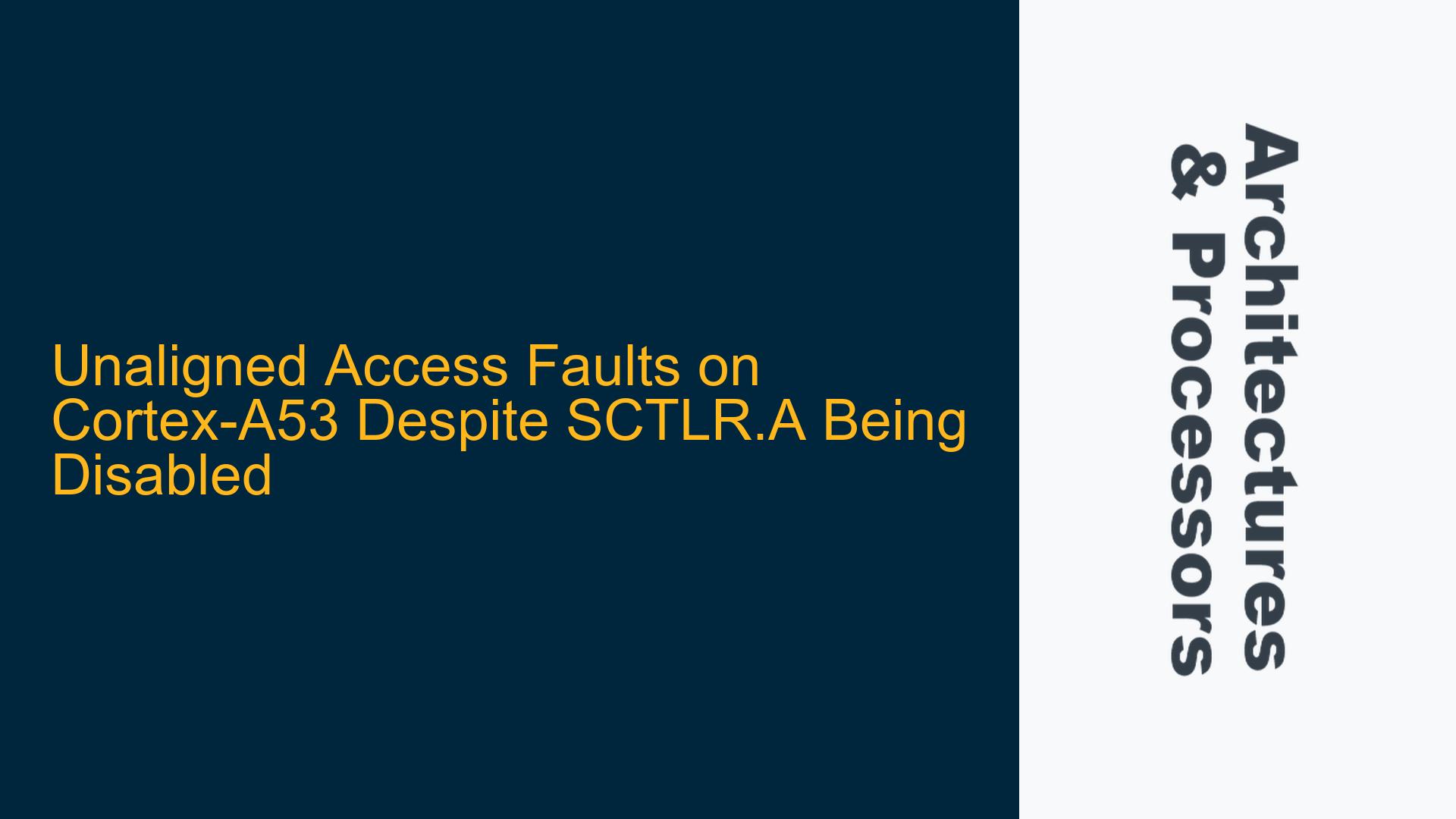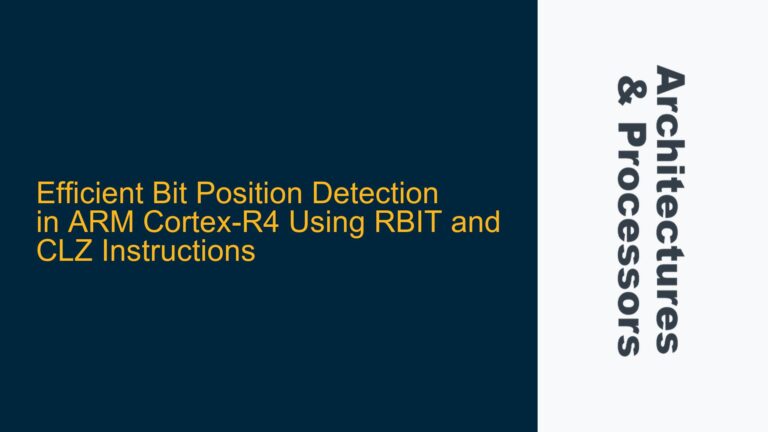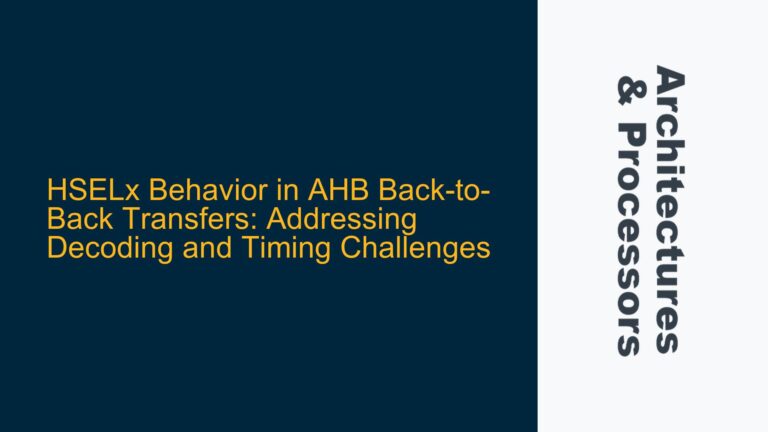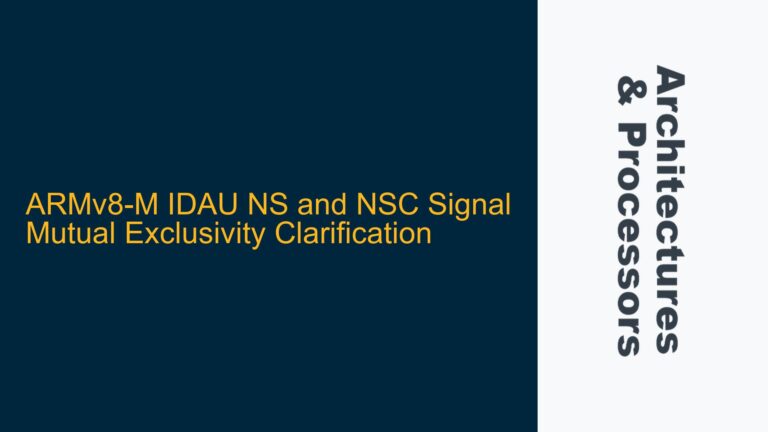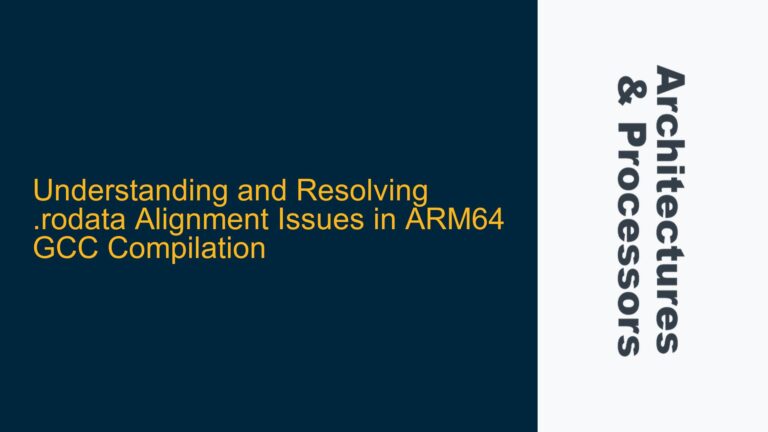Cortex-A53 Unaligned Access Faults with SCTLR.A = 0 in AArch32 Mode
The Cortex-A53 processor, a widely used ARMv8-A core, is designed to handle both AArch64 and AArch32 execution states. In AArch32 mode, the processor supports unaligned memory accesses for certain instructions, such as LDR and STR, when the System Control Register (SCTLR) alignment check bit (SCTLR.A) is disabled (set to 0). However, in some cases, even with SCTLR.A = 0, unaligned accesses to normal memory can still result in alignment fault data abort exceptions. This behavior is unexpected and can lead to significant debugging challenges, especially in embedded systems where memory alignment and performance are critical.
The issue arises when the Cortex-A53 processor is operating in AArch32 mode, and the SCTLR.A bit is explicitly set to 0 to disable alignment checking. Despite this configuration, unaligned memory accesses using STR instructions result in alignment faults. This contradicts the ARM Architecture Reference Manual for A-Profile architecture, which states that unaligned accesses by LDR/STR instructions should be permitted when SCTLR.A = 0. The problem is particularly perplexing because it resolves when the Memory Management Unit (MMU) is enabled, suggesting a deeper interaction between the MMU, memory attributes, and alignment handling.
Memory Attributes, MMU Configuration, and Alignment Handling
The root cause of the unaligned access fault lies in the interaction between the Cortex-A53 memory system, the MMU, and the memory attributes assigned to the accessed memory region. When the MMU is disabled, the memory system defaults to a specific set of memory attributes, which may not fully support unaligned accesses even when SCTLR.A is disabled. The Cortex-A53 memory system relies on memory attributes to determine how memory accesses are handled, including whether unaligned accesses are permitted.
Memory attributes are defined in the Translation Table Descriptors used by the MMU. These attributes include the Shareability, Cacheability, and Memory Type fields, which influence how the processor handles memory accesses. When the MMU is disabled, the memory system uses default attributes, which may not align with the expected behavior for unaligned accesses. Specifically, the default memory type might be treated as Device or Strongly-Ordered memory, which typically enforces strict alignment requirements regardless of the SCTLR.A setting.
Additionally, the Cortex-A53 processor’s handling of unaligned accesses depends on the memory region’s attributes. For Normal Memory, unaligned accesses are generally permitted when SCTLR.A is disabled. However, for Device or Strongly-Ordered memory, unaligned accesses are always faulted, irrespective of the SCTLR.A setting. When the MMU is disabled, the memory system may treat all memory as Device or Strongly-Ordered, leading to alignment faults even for Normal Memory accesses.
Enabling the MMU and Configuring Memory Attributes for Unaligned Access Support
To resolve the unaligned access fault issue, the MMU must be enabled, and the memory attributes must be correctly configured to support unaligned accesses. The following steps outline the process of enabling the MMU and configuring memory attributes to ensure unaligned accesses are handled correctly:
-
Enable the MMU: The MMU must be enabled to allow the processor to use translation tables and memory attributes. This involves setting the SCTLR.M bit to 1. Enabling the MMU ensures that memory accesses are governed by the translation tables and their associated memory attributes.
-
Configure Translation Tables: The translation tables must be set up to define the memory regions and their attributes. For Normal Memory regions that require support for unaligned accesses, the memory type should be set to Normal Memory, and the cacheability and shareability attributes should be configured appropriately. The Translation Table Descriptors should specify the memory type as Normal Memory and enable caching if required.
-
Set Memory Attributes: The memory attributes in the Translation Table Descriptors must be configured to permit unaligned accesses. For Normal Memory, the memory type should be set to Normal, and the cacheability attributes should be configured based on the system requirements. The Shareability attribute should also be set to reflect the memory region’s sharing domain (e.g., Inner Shareable, Outer Shareable, or Non-Shareable).
-
Verify SCTLR.A Setting: Ensure that the SCTLR.A bit is set to 0 to disable alignment checking. This setting allows unaligned accesses to Normal Memory regions when the MMU is enabled and the memory attributes are correctly configured.
-
Test Unaligned Accesses: After enabling the MMU and configuring the memory attributes, test unaligned accesses to verify that they no longer result in alignment faults. Use test code similar to the original example, but ensure that the MMU is enabled and the memory attributes are correctly set.
By following these steps, the Cortex-A53 processor can handle unaligned accesses to Normal Memory regions without generating alignment faults. The key is to ensure that the MMU is enabled and that the memory attributes are configured to support unaligned accesses. This approach aligns with the ARM Architecture Reference Manual and ensures consistent behavior across different memory regions and access patterns.
Detailed Explanation of Memory Attributes and Their Impact on Unaligned Accesses
To fully understand the issue and its resolution, it is essential to delve deeper into the memory attributes and their impact on unaligned accesses. The Cortex-A53 processor uses memory attributes to determine how memory accesses are handled, including whether unaligned accesses are permitted. These attributes are defined in the Translation Table Descriptors and include the following key fields:
-
Memory Type: This field specifies the type of memory, such as Normal Memory, Device Memory, or Strongly-Ordered Memory. Normal Memory supports unaligned accesses when SCTLR.A is disabled, while Device and Strongly-Ordered Memory always enforce alignment requirements.
-
Cacheability: This field determines whether the memory region is cacheable and, if so, the caching policy (e.g., Write-Back, Write-Through). Cacheability affects performance and coherency but does not directly impact alignment handling.
-
Shareability: This field specifies the sharing domain for the memory region, such as Inner Shareable, Outer Shareable, or Non-Shareable. Shareability affects coherency but does not directly impact alignment handling.
When the MMU is disabled, the memory system uses default attributes, which may not align with the expected behavior for unaligned accesses. Specifically, the default memory type might be treated as Device or Strongly-Ordered memory, which enforces strict alignment requirements. This explains why unaligned accesses result in alignment faults when the MMU is disabled, even with SCTLR.A = 0.
Enabling the MMU allows the processor to use the translation tables and their associated memory attributes. By configuring the memory attributes to specify Normal Memory for the relevant regions, the processor can handle unaligned accesses correctly. This configuration ensures that the memory system treats the regions as Normal Memory, permitting unaligned accesses when SCTLR.A is disabled.
Practical Considerations for Implementing Unaligned Access Support
Implementing unaligned access support on the Cortex-A53 processor requires careful consideration of several practical factors. These include the impact on performance, the potential for data corruption, and the need for robust error handling. The following points highlight these considerations:
-
Performance Impact: Unaligned accesses can have a performance impact, especially in systems with tight timing constraints. While the Cortex-A53 processor supports unaligned accesses, they may require additional cycles to complete, particularly if the access spans multiple cache lines. It is essential to evaluate the performance impact and optimize the code to minimize unaligned accesses where possible.
-
Data Corruption Risks: Unaligned accesses can lead to data corruption if not handled correctly. For example, an unaligned write that spans multiple memory locations may overwrite adjacent data. It is crucial to ensure that unaligned accesses are used judiciously and that the surrounding code is designed to handle potential data corruption risks.
-
Error Handling: Even with SCTLR.A disabled and the MMU enabled, there may be cases where unaligned accesses result in faults. For example, if the memory region is incorrectly configured or if the access violates the memory attributes, an alignment fault may still occur. Robust error handling mechanisms should be implemented to detect and handle such faults gracefully.
-
Compatibility with Other Cores: If the system includes multiple processor cores, it is essential to ensure compatibility across all cores. Different cores may have varying support for unaligned accesses, and the memory attributes must be configured consistently across all cores to avoid unexpected behavior.
By addressing these practical considerations, developers can implement unaligned access support on the Cortex-A53 processor effectively and ensure reliable system operation.
Conclusion
The issue of unaligned access faults on the Cortex-A53 processor, despite SCTLR.A being disabled, highlights the importance of understanding the interaction between the processor’s memory system, the MMU, and memory attributes. By enabling the MMU and configuring the memory attributes correctly, developers can ensure that unaligned accesses to Normal Memory regions are handled correctly, aligning with the ARM Architecture Reference Manual. This approach not only resolves the immediate issue but also provides a robust foundation for handling unaligned accesses in embedded systems.
